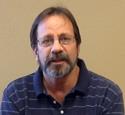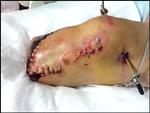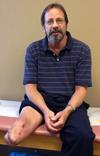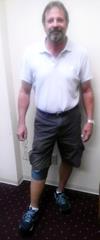Diseases & Conditions
Patient Story: Infection After Fracture

On October 1, 2011, Charles "Skip" Shank's life took an unexpected turn. Skip, a father and avid outdoorsman, was riding his motorcycle when he was suddenly cut off by a car. He tried to avoid a collision, but an impact was inevitable.

The accident crushed Skip's pelvis and severely fractured his right leg, leaving a gaping open wound. He underwent emergency surgery to stabilize his leg. Lisa Cannada, MD, an orthopaedic traumatologist at St. Louis University Hospital, used external fixation, a series of metal rods on the outside of his leg secured to the bone above and below the fracture, to attempt to stabilize the bone and save his limb.
Unfortunately, Skip's injury had caused extensive damage to the muscle and soft tissue. His leg became infected and necrotic. Just nine days after the accident, Dr. Cannada concluded that the leg could not be spared. "When the tissue continued to die, it was determined that the best thing to do was amputate," Skip laments.
On October 10, 2011, Skip's leg was amputated below the knee. In the months after his surgery, Skip developed heterotopic ossification (HO) around his knee joint. HO is the formation of bone in soft tissue. Posttraumatic HO is common and highly problematic. In some patients, HO is asymptomatic; but in others, the abnormal growth causes pain, stiffness, and requires surgical removal.


Skip spent five months in a wheelchair, and eventually graduated to crutches. With the help of physical and occupational therapy, Skip was able to return to his job and start to drive again. In June of 2012, Skip was fitted with a prosthetic leg to allow him to walk without an assistive device. Three months later, he was able to walk down the aisle at his son's wedding.
With daily exercise, Skip continued to gain strength and has adapted to using his prosthesis. "The residual limb is holding up quite well and there seems to be no increase in the HO at this time," he notes.
Each day, Skip encounters obstacles and challenges but, overall, he is thriving. "I have returned to work full time and the leg is doing very well," he says. "Last year I was able to start riding a motorcycle again. I took a couple trips with some friends and had an amazing time." Skip is looking forward to his next big adventure—becoming a grandfather. His son and wife are expecting their first child in May.
Skip hopes that continued musculoskeletal research will help future trauma patients have more favorable outcomes. "Additional muscular and vascular research could have a major impact on the ability to save limbs."
Last Reviewed
August 2014
AAOS does not endorse any treatments, procedures, products, or physicians referenced herein. This information is provided as an educational service and is not intended to serve as medical advice. Anyone seeking specific orthopaedic advice or assistance should consult his or her orthopaedic surgeon, or locate one in your area through the AAOS Find an Orthopaedist program on this website.






